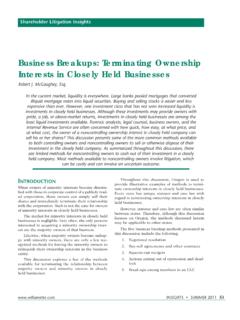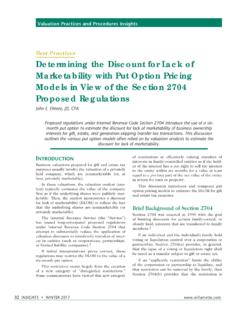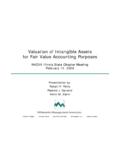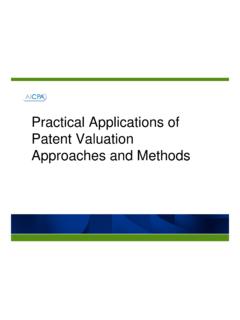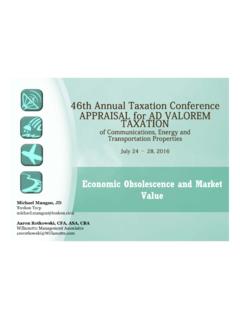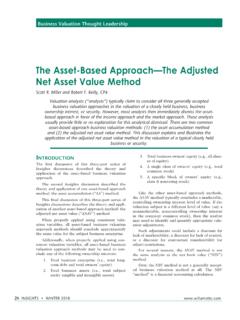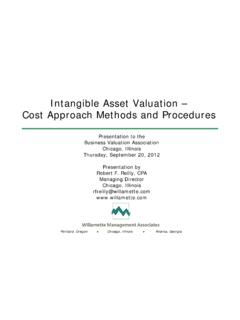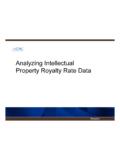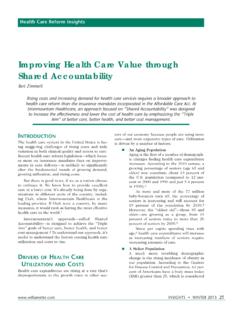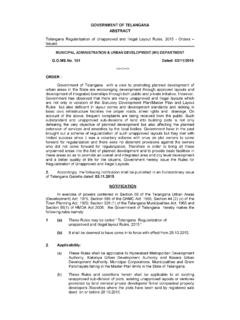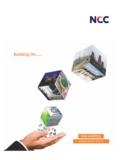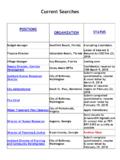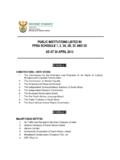Transcription of Valuation of Technology-Related Intangible Assets
1 Www .willamette .com INSIGHTS SUMMER 2015 37 Valuation of Technology-Related Intangible AssetsRobert F. Reilly, CPAE minent Domain and Expropriation InsightsGoing-concern business entities may be the subject of an eminent domain or expropriation action. In such an instance, often, both the business entity s tangible Assets and the business entity s Intangible Assets may be subject to the taking. Therefore, the entity owner should receive reasonable compensation for both the tangible Assets and the Intangible Assets .
2 Many business entities own and operate Technology-Related Intangible Assets . This discussion explains and illustrates the Valuation of Technology-Related Intangible Assets within an eminent domain reasonable compensation many legitimate public benefit reasons, a going-concern business entity can become the subject of a condemnation, eminent domain, or expropriation , these business entities are just in the way of a highway construction, light rail system installation, airport expansion, or other public ben-efit development.
3 Sometimes, the business entity is a utility-type business that operates by the author-ity of a government license or municipal franchise. Some common examples of such utility-type busi-nesses include water and wastewater companies. In such instances, the government or municipal authority that issued the franchise has the legal right to take (or take over) the subject business all of these cases, the government or munici-pal authority that is exercising its eminent domain rights must pay the business entity owner/operator reasonable compensation for the subject business many cases, the agency with eminent domain authority will offer the business entity owner an amount of compensation equal to the value of the entity s real estate and tangible personal prop-erty.
4 However, often, the government or municipal authority is taking more than the entity s real estate and equipment. Often, the government or municipal agency is taking (or, at least, disrupting) the entity s going-concern business a going-concern business enterprise is the subject of an eminent domain or expropriation action, a Valuation analyst ( analyst ) is often called on to value the entity s Technology-Related intan-gible such eminent-domain- related reasonable compensation analyses, the analyst can use any of the generally accepted property Valuation approach-es that is, the cost approach, market approach, and income approach to value such Technology-Related Intangible may be retained by either the busi-ness owner/operator or its legal counsel to perform the technology Intangible asset Valuation .
5 This is because the business entity subject to the eminent domain action also includes Intangible personal property also called Intangible subject entity s Intangible Assets often include Technology-Related Intangible , the value of the entity s Intangible personal property may be part of the reasonable compensa-tion due to the entity owner as a result of the tak-ing. This discussion considers the following topics: (1) the definition of Technology-Related Intangible Assets ; (2) the distinguishing attributes of technol-ogy Intangible Assets ; (3) the typical factors that 38 INSIGHTS SUMMER 2015 www.
6 Willamette .comaffect the technology Intangible asset value; and (4) the factors that analysts consider in assessing tech-nology Intangible asset value and remaining useful life (RUL).In addition, this discussion presents an illustra-tive example of a technology Intangible asset valua-tion related to an eminent domain oF Technology-Related Intangible assetsFor purposes of this discussion, Technology-Related Intangible Assets are broadly defined as Intangible Assets that create proprietary knowledge and pro-cesses.
7 This proprietary knowledge or process may be either developed by, or purchased by, the busi-ness order for a technology Intangible asset to have measurable value, it should provide, or have the potential to provide, a competitive advantage or a product differentiation. Any proprietary technology that confers a competitive advantage or product dif-ferentiation to the business owner/operator may be a technology Intangible following Intangible Assets are typically included in this category.
8 Patents Patent applications Patentable inventions Trade secrets Know-how Proprietary processes Proprietary product recipes or formulae Confidential information Copyrights on technical materials such as computer software, technical manuals, and automated databasesCopyright- related Intangible Assets , software- related Intangible Assets , and patents and related intellectual property are included in the technology Intangible asset category. However, this discussion focuses principally on know-how, trade secrets, pro-prietary processes, product recipes and formulas, and confidential Intangible Assets Due DiligenceWhether or not the Valuation analysis relates to an eminent domain or expropriation action, the analyst should understand the attributes of the Technology-Related Intangible analyst may consider the technology intan-gible asset attributes through the following due dili-gence questions:1.
9 What are the property rights related to the technology Intangible asset ? What are the functional attributes of the Intangible asset ?2. What are the operational or economic ben-efits of the technology Intangible asset to its current owner/operator? Will those opera-tional or economic benefits be any different if the Intangible asset is in the hands of a third-party owner/operator?3. What is the current utility of the technology Intangible asset ? How will this utility change in response to changes in the relevant mar-ket conditions?
10 How will this utility change over time? What industry, competitive, eco-nomic, or technological factors will cause the Intangible asset utility to change over time?4. Is the technology Intangible asset typically owned or operated as a stand-alone asset ? Or is the Intangible asset typically owned or operated as (a) part of a bundle with other tangible Assets or Intangible Assets or (b) part of a going concern business entity?5. Does the technology Intangible asset utility (however measured) depend on the opera-tion of tangible Assets or other Intangible Assets or the operation of a business entity?
